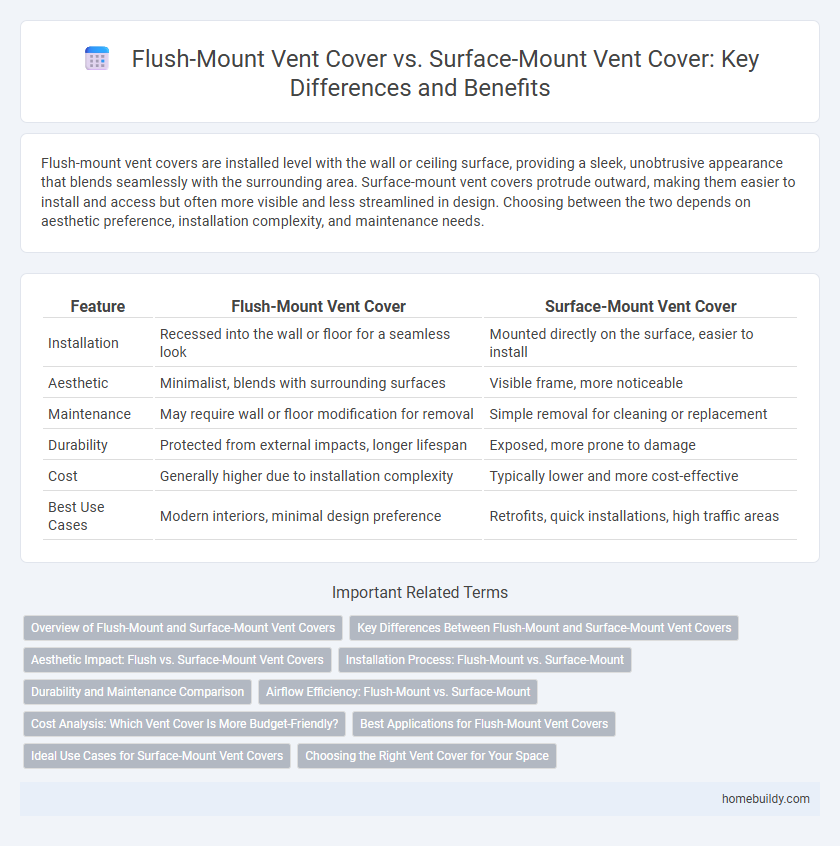Flush-mount vent covers are installed level with the wall or ceiling surface, providing a sleek, unobtrusive appearance that blends seamlessly with the surrounding area. Surface-mount vent covers protrude outward, making them easier to install and access but often more visible and less streamlined in design. Choosing between the two depends on aesthetic preference, installation complexity, and maintenance needs.
Table of Comparison
| Feature | Flush-Mount Vent Cover | Surface-Mount Vent Cover |
|---|---|---|
| Installation | Recessed into the wall or floor for a seamless look | Mounted directly on the surface, easier to install |
| Aesthetic | Minimalist, blends with surrounding surfaces | Visible frame, more noticeable |
| Maintenance | May require wall or floor modification for removal | Simple removal for cleaning or replacement |
| Durability | Protected from external impacts, longer lifespan | Exposed, more prone to damage |
| Cost | Generally higher due to installation complexity | Typically lower and more cost-effective |
| Best Use Cases | Modern interiors, minimal design preference | Retrofits, quick installations, high traffic areas |
Overview of Flush-Mount and Surface-Mount Vent Covers
Flush-mount vent covers are installed seamlessly within the wall or ceiling, providing a sleek, integrated appearance that minimizes protrusion and preserves interior design aesthetics. Surface-mount vent covers are affixed directly onto the surface, allowing for easier installation and removal, making them ideal for retrofit projects or spaces requiring frequent maintenance. Both types offer varying airflow capacities and styles, catering to diverse HVAC system requirements and architectural preferences.
Key Differences Between Flush-Mount and Surface-Mount Vent Covers
Flush-mount vent covers are installed level with the wall or ceiling surface, creating a sleek and unobtrusive appearance ideal for modern interior designs. Surface-mount vent covers protrude outward, allowing for easier installation and maintenance, often preferred in spaces where quick access to HVAC components is necessary. Material choices such as steel or aluminum impact durability, while design variations influence airflow efficiency and aesthetic integration in both flush and surface-mount options.
Aesthetic Impact: Flush vs. Surface-Mount Vent Covers
Flush-mount vent covers offer a sleek, unobtrusive appearance by sitting level with the wall or floor, enhancing modern and minimalist interior designs. Surface-mount vent covers protrude slightly, providing easier access for maintenance but creating a more noticeable visual element. Choosing between flush and surface-mount vent covers depends on balancing aesthetic preferences with functional convenience.
Installation Process: Flush-Mount vs. Surface-Mount
Flush-mount vent covers require precise drywall cutting and embedding into the wall or ceiling, resulting in a sleek, integrated look but demanding more time and skill during installation. Surface-mount vent covers simply attach over existing vents using screws or clips, offering a quicker and easier installation without altering surrounding surfaces. Choosing between them depends on the desired aesthetic and installation complexity, with flush-mount suited for remodels and surface-mount ideal for quick replacements.
Durability and Maintenance Comparison
Flush-mount vent covers offer enhanced durability due to their recessed installation, reducing exposure to physical damage and environmental wear compared to surface-mount vent covers. Surface-mount vent covers, while easier to install and replace, typically require more frequent maintenance as they are more vulnerable to dust accumulation, impacts, and potential deformation. Selecting flush-mount options can result in longer lifespan and reduced upkeep costs, especially in high-traffic or outdoor environments.
Airflow Efficiency: Flush-Mount vs. Surface-Mount
Flush-mount vent covers provide superior airflow efficiency by creating a seamless integration with the wall or ceiling, minimizing air resistance and turbulence compared to surface-mount vent covers. Surface-mount vent covers often protrude into the room space, causing potential airflow disruptions and reduced ventilation performance. Optimal air distribution is achieved with flush-mount designs, enhancing overall HVAC system effectiveness and reducing energy consumption.
Cost Analysis: Which Vent Cover Is More Budget-Friendly?
Flush-mount vent covers typically cost more upfront due to their recessed installation requiring additional labor and potential drywall modifications, making them less budget-friendly for tight renovation projects. Surface-mount vent covers offer a more affordable option, as they install directly onto existing surfaces with minimal effort and no need for extensive wall repairs. For homeowners prioritizing cost-efficiency without compromising ventilation, surface-mount vent covers present a smarter, budget-friendly choice.
Best Applications for Flush-Mount Vent Covers
Flush-mount vent covers are best suited for modern interiors where a sleek, seamless appearance is desired, as they sit almost flush with the wall or ceiling surface. They are ideal for low-profile spaces or minimalist designs, ensuring unobtrusive airflow without disrupting decor aesthetics. Common applications include residential living rooms, offices, and commercial spaces seeking a clean, integrated ventilation solution.
Ideal Use Cases for Surface-Mount Vent Covers
Surface-mount vent covers are ideal for installations where ducts are embedded within walls or ceilings but require easy access for maintenance or airflow adjustments, commonly found in older homes or retrofitted spaces. Their design simplifies installation without extensive drywall or structural modifications, making them suitable for HVAC systems in commercial buildings or rental properties. Additionally, surface-mount vent covers are favored in areas where surface aesthetics are less critical, providing a functional solution that ensures optimal air distribution and ventilation.
Choosing the Right Vent Cover for Your Space
Flush-mount vent covers offer a sleek, seamless look by sitting level with the wall or floor surface, making them ideal for modern interiors and minimizing tripping hazards in spaces with heavy foot traffic. Surface-mount vent covers are easier to install and maintain, as they overlay the existing duct opening, and are suitable for areas where quick access to vents is needed for cleaning or adjustments. Selecting the right vent cover depends on your aesthetic preference, installation convenience, and the functional requirements of your space, ensuring optimal airflow and safety.
flush-mount vent cover vs surface-mount vent cover Infographic

 homebuildy.com
homebuildy.com